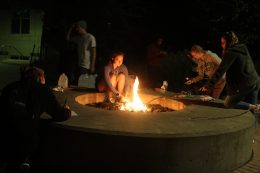
Cooperatively owned housing, or housing co-ops, have never been tried before at Binghamton University. As an alternative to dorms and apartments managed by administrators and community governments, nonprofit housing co-ops are collaboratively governed and operated by students on a smaller scale. Many schools across the country, including Cornell University and the University of California, Berkeley are home to historic and modern housing co-ops.
BU saw a record for student enrollment, over 18,000 just last year, and with only about 7,500 spots available in on-campus living communities, it is clear dormitories and apartments cannot be the only option for housing, nor should they be considered the best way to serve students. As we consider how our campus’ housing can improve, we must consider practicality, as well as cultural impact. With its growing and diverse student population, it’s time the University expand opportunities for on-campus living and look toward housing co-ops as an affordable, sustainable and, most importantly, community-centric option.
Administrators are not shy about investing money in construction projects across campus. Last spring, Old Rafuse Hall was renovated for incoming freshmen and transfer students, allowing the University to accommodate the increase in admitted students. Other projects include a new $60 million lecture hall, a Panera Bread location and renovations to the Chenango Room.
These changes neither facilitate relationship-building on campus nor do they encourage retention among those who’ve chosen off-campus life. BU clearly can expand its campus, and living spaces that promote community, and more housing in general, need to be on the docket.
The University offers six on-campus housing communities currently, the majority of which are dormitory-style. Shared dining halls, recreational fields, community governments and traditions theoretically allow students to meet friends and find community as soon as they enter college. These shared spaces might allow for collaboration and interaction among peers, but the individual-unit structure of dorms fails to promote these values. In housing co-ops across the country, students are communally responsible for household chores, decisions, rules and finances, including rent. This model encourages collaboration among students — acting as one body, not isolated individuals or groups — while providing the same sense of responsibility and independence offered by off-campus housing.
BU’s living-and-learning model, which allows students to connect through career aspirations and common interests and helps alleviate the isolation found in dorm and apartment structures, is limited to select communities — though it should be an ideal for on-campus living culture. Student housing co-ops center connections in their very foundations and are an example of this community-centric design. Co-ops across many colleges are often organized by specific interests, such as religion, political advocacy and even food preferences — one housing co-op at Vassar College, the Vassar Experimental Garden, has taken on growing its own food and one of the oldest co-ops, the University of Michigan’s Socialist House, was founded out of the school’s Socialist Club in 1932.
While over 7,000 students lived off campus in 2023 and students’ moving into the surrounding community is only increasing in numbers, it is clear student retention on campus is lacking, even if on-campus life is preferable. Affordability is one driving factor for this phenomenon. Living off campus is often less expensive than on-campus housing if done right. However, it’s not always the most convenient — for both students and locals. “Renting” from the University and managing finances with your peers is far more predictable than potential landlord horror stories, which many students are no stranger to. Predatory practices, like withholding security deposits, violating building codes and not upholding tenants’ rights, have been weaponized against student renters in Binghamton in the past — all while student rental groups and a lack of family-style housing have contributed to a growing housing crisis in Binghamton.
The surrounding neighborhoods are also not always built for humans but rather for cars and buses, which are neither reliable nor sustainable. Johnson City, for example, holds a “Walk Score” of only 42 out of 100, meaning everyday life requires a car, even as a student. Meanwhile, our campus is walkable and familiar — we see students from our classes all over and connect with those similar to us in our departments, organizations and places of worship and dining, all within 1.5 square miles. We may rent a bike, hike the Nature Preserve or people-watch on freshly mowed grass, all of which come with an added obstacle as an off-campus commuter.
Fortunately, with housing co-ops, students would not have to choose between the affordability of off-campus living and the convenience and joys of on-campus living. Student co-ops have been considered a low-cost option at colleges since their expansion during the Great Depression. Maximum rates at student housing co-ops are consistently lower than the average market rent in the area, sometimes by more than 50 percent.
Amid a 180 percent increase in college tuition since the 1980s and cuts to state funding, co-ops on BU’s campus would ensure students have access to affordable housing and continued education and, more importantly, ensure they are not “priced-out” of the lively campus environment, or push residents from their home. Allowing our students to stay on campus and immersed in the campus community — or create new ones — is important. Housing co-ops make the opportunity to do so equitable.
BU must be responsive to students’ needs, particularly as it concerns housing — community, independence, affordability, etc. — and reflect on the campus environment and values they promote amid construction plans. As BU reckons with the city’s housing crisis and builds an inclusive campus, student co-ops on campus may be the most accessible and sustainable way forward for housing our community.
The staff editorial solely represents the majority view of the Pipe Dream Editorial Board. It is the product of discussions at regular Editorial Board meetings.


